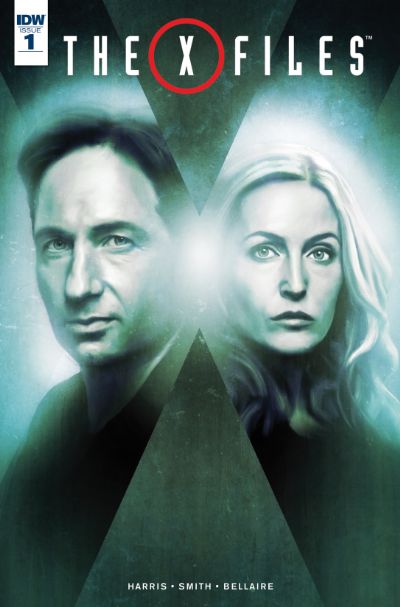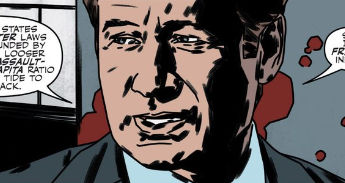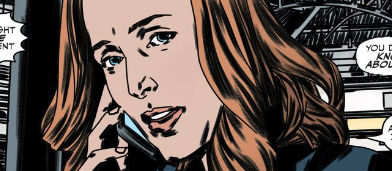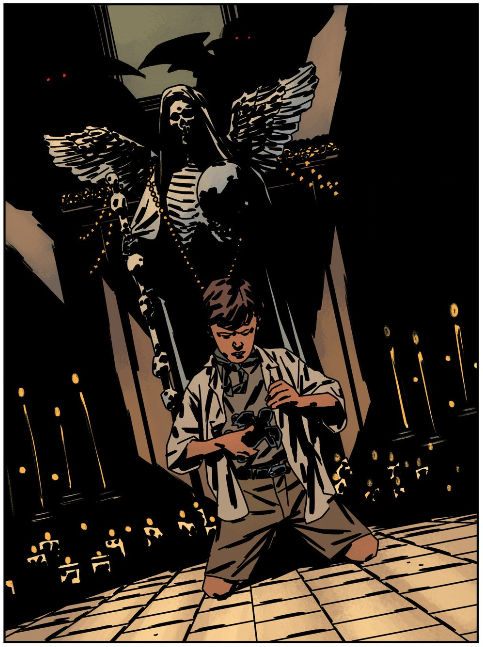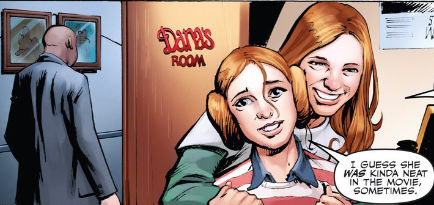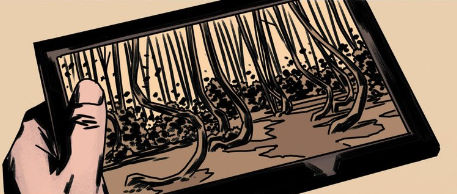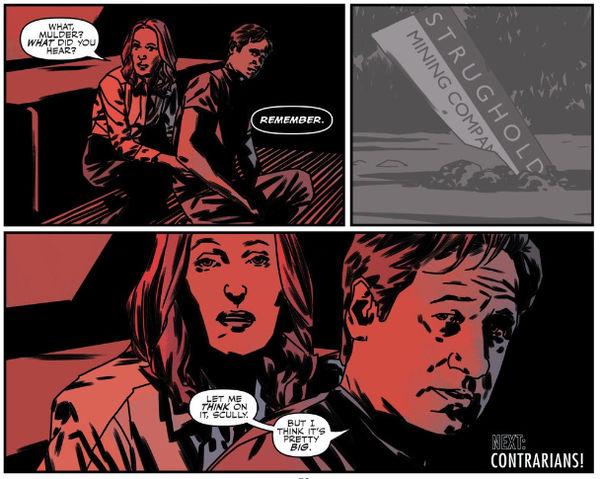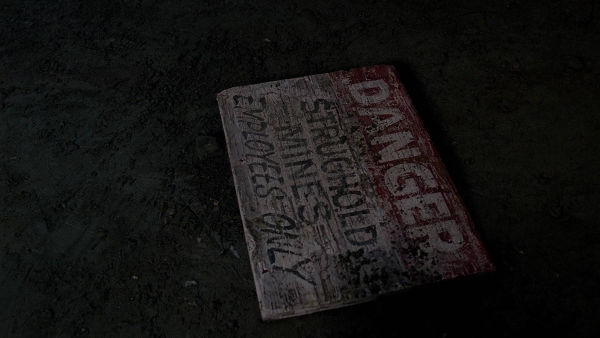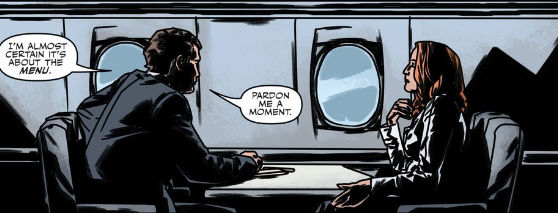The X-Files comics by IDW have been covered extensively at EatTheCorn. The main series was a continuation of the season 9/IWTB storyline, written by Joe Harris, and which managed the impossible: to serve an elegant conclusion to the mythology. The “Season 10″/”Season 11” series ran from 2013 to early 2016 and for a long time was the continuation of the series, considered canon. That is until the 2016 revival started to materialize and pushed the comics into non-canon territory. Alas, I found the comics more interesting and satisfactory than what the live revival proposed; you can find all the detailed EatTheCorn reviews of these comics, one per issue, here.
The live series taking precedence over the comics due to how many eyes saw it, IDW adjusted itself to the new canon of the live revival. It accelerated and cut short its “Season 11” series, which wrapped up with the “Endgames” story in March, and in April relaunched a new series, simply titled “The X-Files” (or “The X-Files Ongoing“) shortly after the revival aired in January-February. Joe Harris is still the writer for the series, bringing his own sensibilities — such as his progressive politics and his interest in the geopolitical aspects of the mythology. Chris Carter is still credited as Executive Producer and this is still labelled as “official canon”, but we now know this is more of a marketing façade rather than anything of true meaning.
The “ongoing” series is thus set in the continuity defined by the revival. It’s unclear when exactly, with some IDW interviews mentioning it takes place during the revival (so in between the bookend My Struggle episodes; those were some busy 6 weeks!) and others placing it after the resolution of the My Struggle II cliffhanger (implying that we are to expect that everything will return to “normal” despite the cataclysmic events in that episode?). Of course, the revival did all kinds of controversial things with the mythology of the show, to the point where it is nigh impossible to do a mythology story without risking to contradict whatever story the revival was attempting to develop (and might develop more if more episodes are made). This is an impossible exercise, and the best approach would be to develop a parallel mythology, which is what Harris seems to be doing.
The new comics series follows the look established by the revival series: Mulder has aged quite a bit, Scully has her horrible wig, they are no longer a couple (or at least shown to be one), Skinner is the same but sports a beard. Matthew Dow Smith is again the main artist, and is still great both in drawing the new likenesses of the actors and in creating darkly lit panels that fit the dark mood of the show; Jordie Bellaire and menton3 still excel in colors and covers, respectively.
An overall impression of the first 9 issues is that they are much less engaging than the Seasons 10/11 comics. Stories either lack narrative flow (Active Shooter, Came Back Haunted) or are downright hard to believe (Ishmael). Harris had to cut short his ambitions with his own S10/11 storylines and start new ones from scratch, with the added enormous uncertainty surrounding the nature of the mythology after the live revival. One could go as far as to say that maybe his heart is no longer into it; his attention is certainly spread thin, as he has many comics series going on at the same time. The quality of the comics is reflected in the sales (at least physical, non-digital, sales), which have regularly dropped from the very beginning of the series. They are now significantly lower than where Seasons 10/11 were and are in similar territory to those of the Millennium comics, which did not go further than the first 5-issue story because of this. Perhaps the reception of the comics is also suffering from the lukewarm reception the live revival itself got as well. This doesn’t automatically mean IDW might discontinue the series just yet, given that The X-Files is important as a brand name to feature. See below (source):
Upcoming issues are character pieces that focus on the CSM and Skinner (#10-11: Contrarians, #12-13: Skinner) that should be pleasing for fans; these could very well be ideas that Harris had for his Season 11 that never got made. Time will tell, after #14, if the series overall will get more interesting. Given the delays in the potential production of more live episodes, Harris might get ample time to figure out a direction and stretch his mysteries. No end in sight for this franchise!…
Spoilery reviews of the first 9 issues (March-December 2016) follow after the jump!
#1: Active Shooter
The first issue establishes the series with a single-issue story. As seen in previous attempts, e.g. S10 #9: Chitter, one issue is very short to tell an interesting story, especially now that issues have shortened to 20 pages instead of 22 or more. Events unfold very quickly, scenes change abruptly, the plot bears many coincidences to make much sense (multiple hostage situations in the same building the same day without Scully being aware?)… In future issues that lesson seems to have been learned, as stories cover at least two issues.
As such, this first issue is an introduction to mysteries that will return in the larger “mythology” in #6-9: Came Back Haunted. We are introduced to what looks like a controlled experiment, where individuals are under surveillance labelled as test subjects in an exposure group (“*GROUP SUB ** EXP +** HRS“). To what they were exposed, we do not know yet, but it made them violent — reminiscent of the mind control experiments in sprayed chemicals in 2X03: Blood or in TV signals in 3X23: Wetwired.
The framing of the story is one of mass public shootings, a staple in American events in recent decades and unfortunately something that seems to be on the rise in recent years and months. Connecting the X-File case to current events is a very welcome move and helps make the story interesting and fresh.
#2-3: Día De Los Muertos
(Also labelled as “Dia De Muertos“, “Días de los Muertos” and “Muertos“. Spanish is not their forte.)
The story here centers around a ruthless Mexican drug lord that is expanding operations in the US side of the border, and the revenge exacted on him by two children he had left orphaned. The paranormal element is from Mexican folklore: Santa Muerte (“Holy Death”), a deity resulting from the syncretization of Aztec and Christian faiths, celebrated on the Day of the Dead (which coincides in date and spirit with Hallowe’en and All Souls’ Day). She and the celebration is indeed associated with the Mexican marigold flower, cempasuchil (misspelt here as “cempaúchil”), the “flower of the dead”. She is worshiped more in the center and south of the country, which is why in the story the cartel is based off Oaxaca — although it is not a major drug trafficking territory and, while immigrants do transit from there, it is too remote from the border to have trainloads of immigrants moving north.
The X-Files has been in Mexican territory before, with the parody episode (and in my solitary opinion, it seems, a good one) 4X11: El Mundo Gira, and the “Traffic“-inspired 9X07: John Doe. In both these cases it escaped the cliché suffered by the Mexican people in the eyes of their US neighbors: drug cartels. To be fair, XF did have its share of non-WASP clichés, and illegal immigration from Mexico is one of those hot topical themes in 2016.
But if one passes these elements, the story is actually well executed and makes for a solid “monster-of-the-month” case. It is one of these cases, of which the series had many, where Mulder and Scully encounter a paranormal phenomenon but ultimately have little effect on the plot. They investigate a crime scene, talk with witnesses, Scully does autopsies, Mulder brushes with the monster (and miraculously escapes death himself!), but they neither prevent more murders to occur nor catch the supernatural killer.
#4-5: Ishmael
How to suddenly pick up interest in your product? Reveal a shocking secret from the past! This is the method chosen here, with the revelation of an old Scully family secret that is tied to a supernatural mystery today. Alas, Harris plays for maximum shock value and the secret itself is one that is hard to believe in given what we knew of the characters and their morals.
It is revealed that around 1975-1977, William Scully, Dana’s father, had a relationship with a Vietnamese woman he helped save in the Vietnam war; Dana witnessed her suicide when Scully Sr. refused to assist her further or continue the relationship. The attention to detail of Scully’s background is remarkable: as seen in 3X15: Piper Maru, the Scully family was indeed stationed in the Miramar Naval Air Station in San Diego while the father of the family was serving in the Navy, and young Dana was indeed friends with the son of a colleague of her father, Richard Johansen (here named Ritchie; he later died in the Gulf War). Although I’m not sure Dana Scully would have been enough of a fan of Star Wars to don a Princess Leia haircut (released in 1977). And of course Scully Sr and Dana called each other Ahab and Starbuck, from Herman Melville’s “Moby Dick” (established in 1X12: Beyond the Sea). Featuring the long-deceased Queequeg on the cover of #5 was a nice touch!
Given how Scully Sr. was always a moral compass Dana looked up to, it is difficult to accept he would do such a thing (and hear him call her affair “sweet lotus flower“!) to the point this feels wildly out of character. Additionally, the woman Scully Sr. had an affair with had a baby (not from him, at least!) who grew up to be a petty criminal; and Dana knew exactly who he was and where to find him! Dana Scully knowing about all this and never once contacting him feels further out of character.
Today, decades later, Scully is stalked by an individual obsessed with her, someone who has a psychic link with her, channels what she says and hears, and has intimate knowledge of these secrets from the past. The reason why Scully and this deranged person are linked is never established. He fixated on Scully, kidnapped her, got caught, and in one of his intense psychic seizures he dies.
Furthermore, the art in these issues is by guest artist Andrew Currie; his colorful and bright art is completely in-adapted to the world of The X-Files and would be more fitting for a young adult series.
The whole thing is more than forgettable.
#6-9: Came Back Haunted
After these “monster-of-the-month” issues comes the first story that is self-described as a mythology story. Which means opening mysteries for later issues to explore.
The beginning of the first issue is a repetition of the revival’s Babylon — Middle Eastern man living in the US, Muslim prayer, suicide bombing — which is surprising. Babylon had already received bad press for repeating the Muslim terrorist stereotype a few months ago; however, recent events in Europe and Turkey have not helped to cool things down.
The Muslim extremist terrorist theory is disproven soon enough, as the case is linked to the “exposure” experiments of the first issue. Something old and sinister has been dug up in Hungary, and this entity is spreading like an infection. The “infection” makes the host’s eyes brighten up like fire, and it hops from person to person — if the host doesn’t go mad and kills himself first, that is. There are of course similarities to the Black Oil — “evil” infection, spreads through the eyes. But most relevant, the “evil as a contagious disease” idea and the burning eyes are exactly similar to 8X17: Empedocles; this new evil might prove to be the same as the one from the episode, but for the time being Harris does not directly reference the episode. The idea of treating evil like a disease that corrupts individuals and institutions was also investigated in the third season of Millennium, some years before 8X17: Empedocles; along with episodes like 9X04: Hellbound and 9X16: Release, I believe it could have constituted the core of a new mythology centered around Doggett and Reyes. Harris might be picking up this thread here.
Mulder identifies the Hungarian wood with the oddly shaped trees: the “haunted” Hoia-Baciu forest in western Romania. This is a real forest and the trees there are indeed remarkable. It has been dubbed the “Bermuda triangle of Transylvania” because of the alleged paranormal phenomena there, including UFO sightings and balls of light in the sky. The comic story takes place in the Hajdu-Bihar region in Hungary, which is across the border from Hoia-Baciu. Perhaps Harris moved the action of the immigrant work camp in Hungary instead of Romania because of the rising fascism in Hungary (anti-semitic Jobbik far right on the rise, 2016 referendum rejecting the welcoming of barely 1,000 Syrian refugees in a Europe-wide burden sharing). Of course, one can’t mention “Transylvania” and “possession” without thinking of all the vampire and Count Dracula myths of the region; this might come into play later.
What they dig up there seems to be a hive mind-like energy entity that absorbs the mind of those infected. “Old Ones wait. Old Ones know. Old Ones lie deep beneath.” “To gaze into the holes in the sky.” There are definitely some elements of Lovecraftian horror here, with ancient forces much superior to mankind rising from the deep. The oft-repeated “holes in the sky”, visible only to the infected and so horrible it can literally make you mad, seems like a parallel reality accessible only to select few — also reminiscent of H.P. Lovecraft and works he has inspired, like John Carpenter’s “At the Mouth of Madness” or the end to the first season of “True Detective“.
The entity infects Mulder and sends him to the source, in Hungary. This is a similar situation as in Harris’s own Season 10 arc Pilgrims, only Mulder had been infected by the Black Oil. Mulder finds himself in a labor camp, where prisoners are forced to dig in order to release more of the mysterious entity; this also is reminiscent of past episodes, namely the Russian gulag in 4X09: Tunguska / 4X10: Terma. The big reveal is that the whole mining operation is orchestrated by “Strughold Mining Company“. The fan will link that to Conrad Strughold, the apparent head of the Syndicate only seen in the Fight the Future film. The attentive fan will remember a plaque similar to that seen in the comics, in the files storage facility in an abandoned mine in 3X02: Paper Clip! Harris once more shows his knowledge and love of the show’s (old) mythology. Remnants of the old Syndicate, if not old Conrad himself, have survived, and are still proceeding with their dark plans. These plans apparently involve the monitoring of those infected, as first seen in Active Shooter; the woman monitoring them is killed here by Ben-Brahim’s men. These are all the slim elements this story arc reveals, however this is obviously a setup for a continuation in later issues.
The mythology story is told within a larger frame, which is that of the refugee crisis. This is another element of current news intelligently incorporated in the X-Files by Harris. The result of extremist Islam or American interventionism in the area, depending on who you might ask, the refugees fleeing war and the associated humanitarian crisis occupy the European news daily for some two years now. The refugee crisis has been a real bonanza for NGOs and other aid organizations, which get significant amount of financing from State and international institutions to provide much-needed help. We are introduced to one of them, the Shyma Foundation, headed by Firas Ben-Brahim.
Ben-Brahim is a wealthy individual that talks a lot about his impressive humanitarian achievements — for example his refugee sheltering facility in the middle of the Atlantic ocean — but appears to be hiding his own agenda as well. His plane appears to be equipped with some advanced nanotechnology, as it self-seals after an explosion. He is able to extradite Mulder with a private military platoon. He is the target of infiltration and attacks on behalf of the Bihar entity, perhaps on behalf of the Syndicate as well. He seems to have some Tad O’Malley in him, including in the way that he offers Scully a drink and at times seems to be flirting with her — something that is bound to get on the nerves of a part of the fandom, albeit in line with the new direction defined by Carter. It is clear that Firas’s character will be further developed in future issues, as the mysteries around him are merely introduced here.
The whole series seems to be teeming with cameos. Firas is drawn like Mads Mikkelsen, which is of course significant since he and Gillian Anderson shared the screen in “Hannibal” (the comics even include them both onboard of a plane, which mirrors exactly the “Hannibal” second season finale!). The Quantico technician is a Kumail Nanjiani lookalike. The pilot of Firas’s plane is a Simon Pegg lookalike.
In all, these issues present some interesting elements, a mix of the new and current world of the 2010s, with elements that seem recycled from older X-Files episodes. Harris begins to build his new mythology and it will be interesting to see where he takes this. However, the four issues follow a slow pace and a confusing plot; they are not as enjoyable as Harris’s previous multi-issue mythology stories. The entity jumps body and kills somebody; then we jump to Firas who talks to Scully; then again to another random victim of the entity. The whole thing is talky and is plotted rather confusingly and without a real sense of pace and climax. It could have flowed better had it been a 3-issue rather than a 4-issue story (especially compressing the second issue and tightening the ending in the fourth issue). Despite the length, at the end we are left with what feels as not even the first part of a story but an introduction, a mere scratching of the surface, with the real plot to come later.
